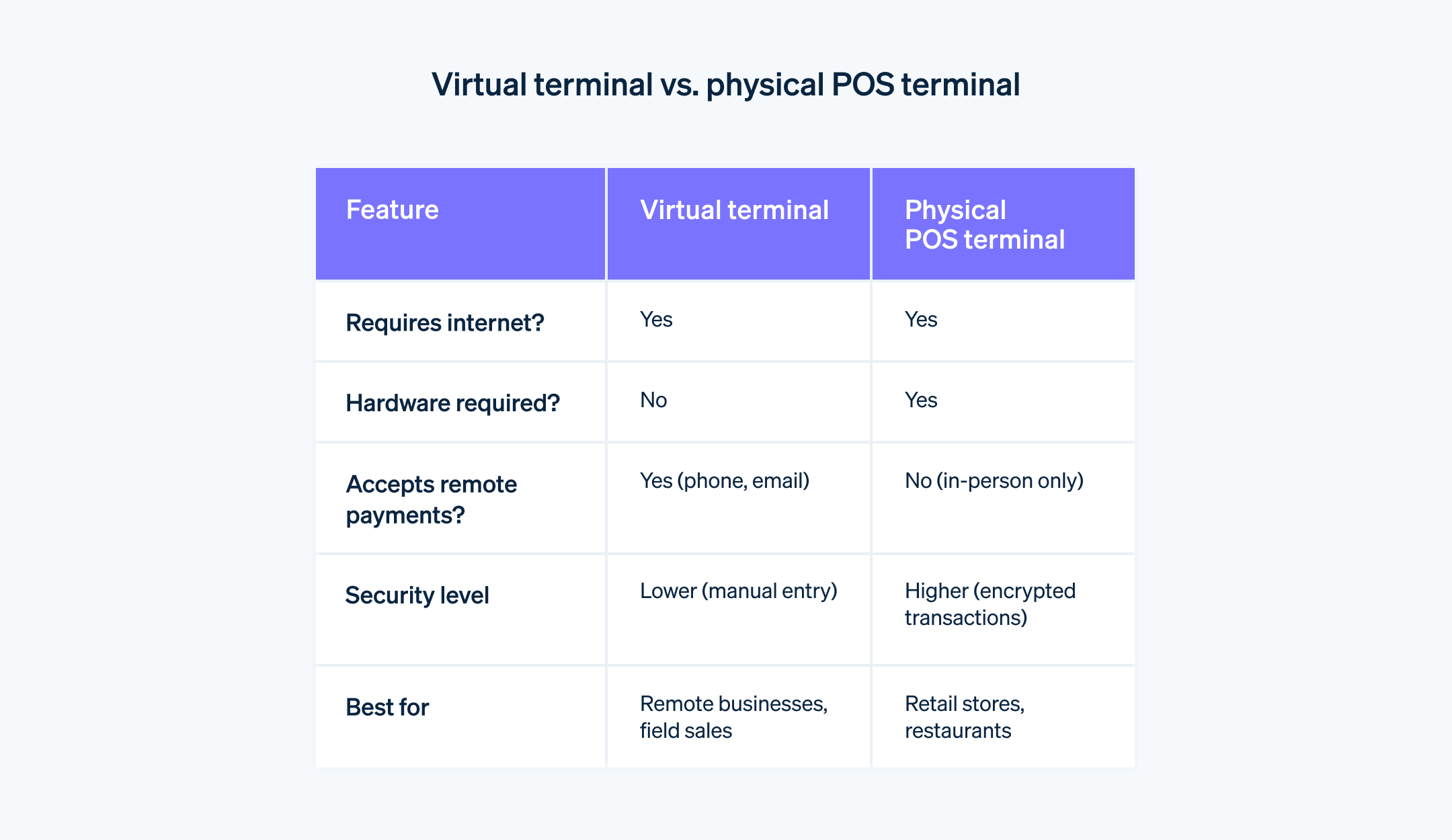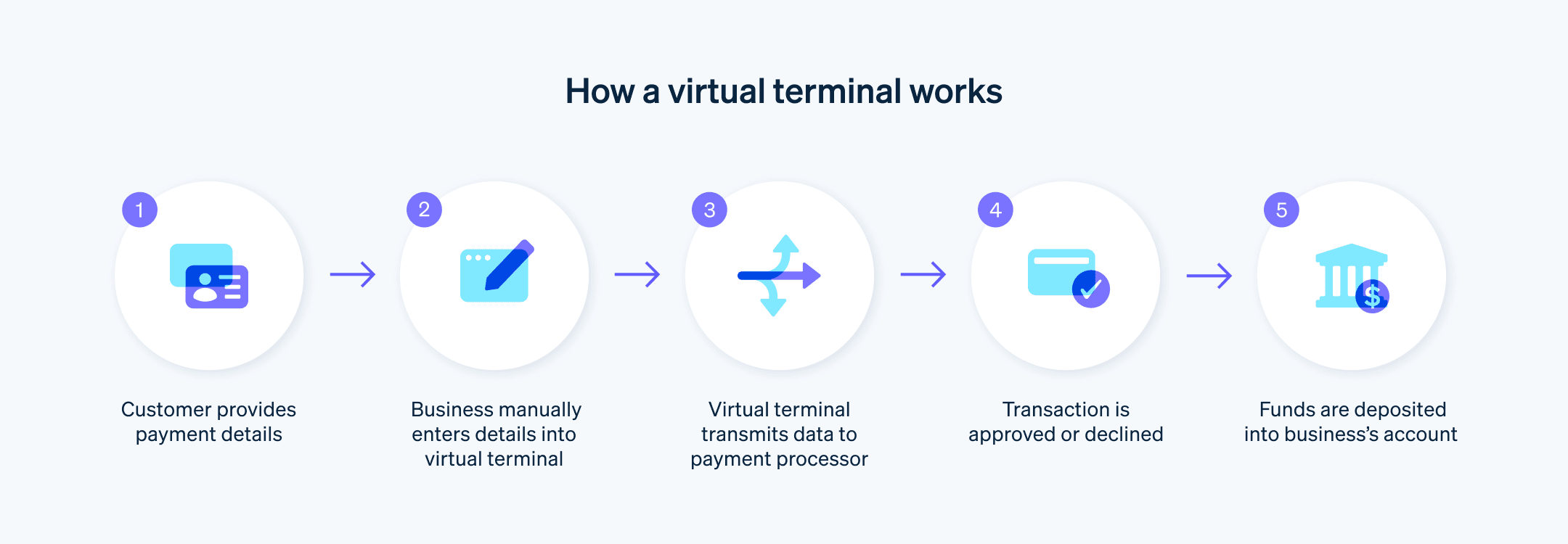建立一个能够随时随地接受客户付款和处理销售的支付系统是构建成功业务的重要一环。那么,在无法使用常规支付处理终端时怎么处理销售?
这时虚拟终端就派上用场了。对于大多数用户来说,虚拟终端不是支付系统中的标配,但它可以是一个重要的补充。
我们将介绍虚拟终端是什么,它如何运作,为什么可能需要使用它,以及 Stripe 用户应了解的设置相关内容。
目录
- 什么是虚拟终端?
- 虚拟终端如何运作?
- 哪些类型的企业使用虚拟终端?
- 使用虚拟终端的好处和主要风险
- 是否提供虚拟终端?
什么是虚拟终端?
虚拟终端通过基于网络的软件运行,使您无需使用物理 POS 终端即可电子处理付款。即便通常使用 POS 终端的用户,虚拟终端也可以作为一种额外的方式,以便在传统支付终端无法使用时,处理来自多种来源的客户交易。

虚拟终端如何运作?
企业可以使用虚拟终端通过电话、电子邮件、传真或配备互联网的设备(如笔记本、平板电脑或智能手机)接受客户付款。大多数虚拟终端接受信用卡、借记卡和 ACH 付款。与通过读卡器完成的线下交易不同,虚拟终端需要用户手动输入交易和付款信息。

哪些类型的企业使用虚拟终端?
大多数接受客户付款的企业都能从虚拟终端中受益。即使不经常使用,虚拟终端作为支付系统的一部分也意味着您永远不会因意外的交易而延迟处理。对许多企业而言,虚拟终端在日常运营中非常理想。以下是一些示例:
餐馆
餐馆等食品类企业经常会在短时间内接受在线、电话和线下的客户订单。虚拟终端可以作为餐馆支付系统中的一个关键部分,以便处理来自各种输入来源的交易。零售商
在多种场所进行销售的零售商也可以从虚拟终端中受益。例如,如果您在经营一家手工陶艺的实体店,同时还会在手工艺品展会或朋友间非正式销售,有了虚拟终端,您可以在任何地方处理付款。自由职业者和顾问
如果您是很少与客户见面的自由职业者或顾问(例如写作、设计、会计等),虚拟终端使您无需投资物理 POS 终端或读卡器即可轻松接受付款。
使用虚拟终端的好处和主要风险
随时随地处理客户交易的便利性显而易见,但这种便利也带来一定风险。以下是使用虚拟终端处理付款的优缺点:
优点
- 便利性
虚拟终端可在任何带有浏览器的设备上使用。由于大多数人随时携带智能手机,虚拟终端可以随时方便地访问。 - 灵活性
虚拟终端可以在几乎任何环境中使用,通过多种方式接受付款——面对面、电话、电子邮件,甚至是邮寄方式。 - 挽救可能失去的销售机会
虚拟终端最大的优点是,即使商家不在实体或在线支付终端旁边,它也让商家(或指定员工)可以轻松处理客户交易。这意味着企业不会因无法处理付款而失去销售机会,从而避免了潜在的收入损失,以及客户终身价值 (LTV) 的减少。
- 便利性
风险
- 安全问题
虚拟终端的主要缺点在于其安全性。在使用读卡器完成的线下付款中,读卡器会将卡片信息安全传输到用户的 POS 系统,然后传送到支付处理商。通常,这些信息在传输过程中会被加密以进行授权。而在“无卡”(CNP) 在线交易中,客户需要输入付款信息,如卡号、CVV 码和账单地址。使用虚拟终端手动输入付款信息时,由于用户需亲自输入付款细节,这种方式相比其他付款方式具有较高的安全风险。
- 安全问题

是否提供虚拟终端?
使用 Stripe 的企业可以在其平台上添加虚拟终端。但是,它们不是 Stripe 开箱即用解决方案的一部分,主要是因为它们更难确保遵守我们毫不妥协的安全标准和 PCI-DSS 合规性。
在您的 Stripe 账户上添加虚拟终端需要一个 API,我们可以帮助您进行设置。创建虚拟终端后,您将能够通过 $$ 管理平台Stripe Dashboard从任何浏览器访问它。我们的目标是平衡企业随时随地接受付款的能力,同时确保付款尽可能安全。为了保持高安全标准,虚拟终端支付应被视为一种有用但罕见的备用方法,用于通过电子邮件、传真或电话接受付款。
本文中的内容仅供一般信息和教育目的,不应被解释为法律或税务建议。Stripe 不保证或担保文章中信息的准确性、完整性、充分性或时效性。您应该寻求在您的司法管辖区获得执业许可的合格律师或会计师的建议,以就您的特定情况提供建议。